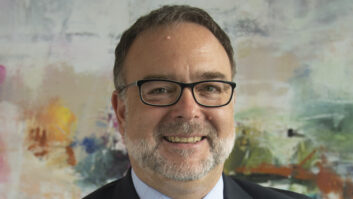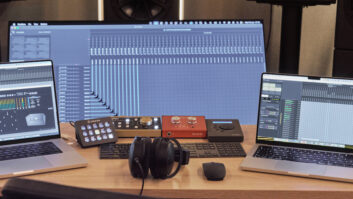
From top to bottom: AirTools 6200 (released in 2005), Symetrix 628 (1997), Symetrix 528E (1993), Symetrix 601 (1992) and the original Symetrix 528 (1983).
In the early 1970s, Symetrix founder Dane Butcher worked as a recording engineer with members of Return to Forever and helped engineer Herbie Hancock’s Head Hunters. He was captivated by recording equipment and envisioned creating affordable, high-performance signal processors. “I had too many product ideas to continue recording!” Butcher laughs.
Butcher took a job working for Greg Mackie at Tapco and learned to design electronics. In 1976, only six months after taking the Tapco job, Butcher started Symetrix in an artist’s loft and former garment factory in the Belltown area of Seattle. Butcher and his first employee, James Husted, found they could supplement their modest Symetrix income by doing repair work and studio maintenance around town.
A surplus electronic components company was located across the street, and with their parts Butcher manufactured the very first Symetrix product, the SG-1 Signal Gate, as well as the company’s subsequent compressors, limiters and phasers. Symetrix’ first products were aimed at the studio and live P.A. markets. After about two years, the small Symetrix team was able to work full-time for the company.
As the years went on, Butcher and his team developed a knack for finding and fulfilling unmet needs in related markets. “By the early 1980s we’d had some success in the broadcast market making telephone interfaces for talk shows,” Butcher explains. “We wanted to do more, and so we thought, what about the very front end? There was no inboard processing on a broadcast mixer, so we put together a good mic pre, a compressor/limiter tweaked for broadcast, a downward expander, a de-esser and a 3-band parametric EQ, all in one box. It wasn’t a giant engineering feat. We only had to combine technologies that we had already mastered in other products.” The result was the 528 Voice Processor, an early hit.
The company applied that same ingenuity to the installed sound market. “For a small signal processing company, we go across a large number of markets,” Butcher says. “However, we came to the conclusion that those markets were having trouble identifying with one company that could work in so many different areas. They were used to companies that vertically aligned themselves. We decided to communicate our dedication to each market by branding our products accordingly.”
With that decision, the Lucid, AirTools and SymNet brands were launched. The Lucid brand serves the digital recording studio market with low-jitter converters and master clocks; the AirTools brand serves the broadcast market; and the SymNet brand serves the installed sound contractor market with general purpose DSP products that are expandable and scalable.
For more information, visit www.symetrixaudio.com.






